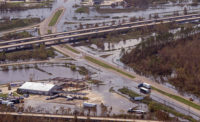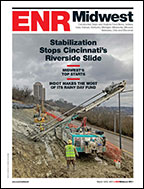 |
| Shift. Investigators say 17th Street Levee was not overtopped, but "moved about 35 ft laterally." (Photo by Tom Sawyer for ENR) |
Engineers studying the performance of New Orleans levees during Hurricane Katrina say there are signs of soil mass movement at two of the five Orleans Parish sites where floodwalls failed, but no evidence that the walls were overtopped.
"A section of the levee embankment that supported the floodwall on the 17th Street Canal moved about 35 ft laterally," a statement from the team says. It adds that evidence of soil mass movement was also seen at the London Avenue Canals north breach. The observations were presented at an Oct. 7 press conference in a statement read by Peter Nicholson, a University of Hawaii civil engineering professor. Nicholson is head of an American Society of Civil Engineers contingent in a team of engineers inspecting damage.
The team consists of members of the American Society of Civil Engineers and a National Science Foundation-funded group from the University of California, Berkeley. They are working with the U.S. Army Corps of Engineers and researchers from Louisiana State University.
While there is evidence of movement, "we need further testing to develop analysis," says Corps investigator Paul Mlakar. Another investigator, Cal-Berkeley Civil Engineering Professor Raymond Seed, added that signs suggest movement caused by hydrostatic force, not by load on the floodwalls.
The investigators also confirmed that the breach on the 17th Street Canal appears to include an area where the contractor who built the walls in 1993 encountered construction difficulties. At the time, the contractor claimed they were caused by problems with existing sheet pile "structural integrity" and soil instability.
According to Corps documents, contractor Pittman Construction Co. Inc., New Orleans, had a $2.6-million contract to top sheetpile already embedded in the canals east-side levee with poured-in-place monolithic concrete panels. Some panels were rejected by the Corps because they were misaligned.
According to the documents, Pittman, which no longer is in business, claimed sheet piles shifting in weak soil during the concrete pour were to blame. Pittman also said the soil conditions differed from those shown in the contract and that the Corps was unresponsive to its requests for soils data to resolve the problem. Pittman sought an additional $809,659 and an 80-day extension.
|
The Corps countered that faulty formwork bracing, whose design and use was the contractors responsibility, caused the problem and denied the claim. In 1998 the Corps Board of Contract Appeals, in a binding Alternative Dispute Resolution proceeding, found for the Corps. The records indicate a large amount of data on soil conditions and wall construction was on file at the time. Investigators have pledged to dig deeply into that material of record.
Soil borings also are now be-ing collected throughout the system, especially near damaged areas. "One problem with analyzing such an event is that much of the evidence was washed away," says Mlakar. Seed adds that the breach on the southeast side of the London Canal, for instance, "is a mystery... because we have nothing left to work with."
Another breach that remains a puzzle is on the Industrial Canal where a straying barge may have knocked out a floodwall. Seed says that the wall was "severely distressed" and may have been struck, but it is too soon to say if thats why it failed.
The investigators say they are not ready to draw conclusions about cause, including possible design or construction defects. "Our obligation is to obtain data objectively and not speculate," Mlakar says. "A lot of possibilities have been suggested....The purpose of our work is to gather information to discuss all of those possibilities."



Post a comment to this article
Report Abusive Comment